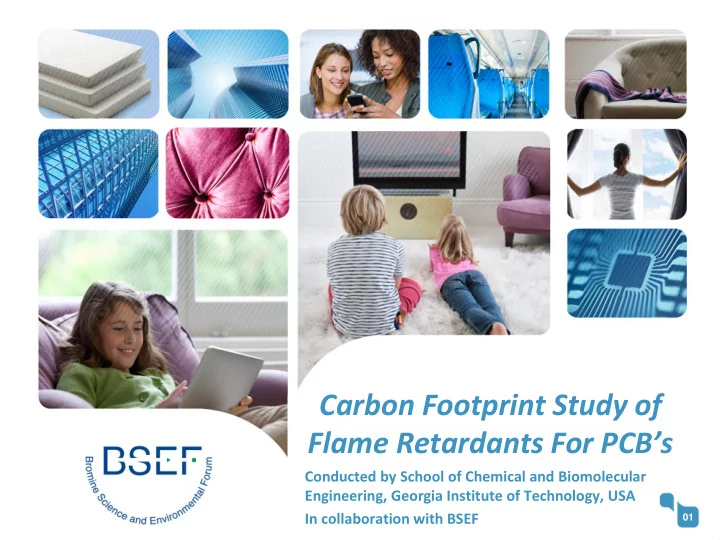

Carbon Footprint Study of Flame Retardants For PCB’s Conducted by School of Chemical and Biomolecular Engineering, Georgia Institute of Technology, USA In collaboration with BSEF 01
Policy Context • On 17 July 2012, the European Commission published an harmonised methodology for the calculation of Product Environmental Footprints (PEF) • These guidelines were developed by DG Environment together with the European Commission's Joint Research Centre • The adoption of the policy that applies the methodology it is scheduled either for December 2012 or early 2013
BSEF Life Cycle Analysis (LCA) project Project Outline: Carbon Footprint Study of Flame Retardants For Printed Circuit Boards (PCBs) Conducted by School of Chemical and Biomolecular Engineering, Georgia Institute of Technology Developed engineering based LCA analysis of blocks that can be assembled into different supply chains. Created data for each block of the inventories of mass, energy and emissions based on transparent engineering design principles of representative processes Objective: To calculate the impact that the selection of different flame retardant chemistries have on chemical products and on the use in PCBs as carbon footprints. Phase I: calculate the carbon footprint of two representative flame retardants, TBBPA and DOPO Phase II: Calculate the carbon footprints of different copolymer systems
Approach: Modular Engineering Based LCI Develop engineering based analysis of blocks that can be assembled into different supply chains . Specific Chemical Gate – to-Gate Chemical/Product Inputs Block Output Create data for each block of the inventories of mass, energy and emissions based on transparent engineering design principles for representative processes. “Cradle -to- Gate” All the activities necessary to convert raw materials through to final chemical production, does not include packaging, use, and end-of-life stages. Composed of Gate-to-Gate blocks. A cradle-to-gate calculation for a key intermediate “Cradle -to- Gate Module” chemical in a complex production process.
Average or Representative? Average LCI Data Representative LCI Data Pick system/process technologies that industry Some LCI data generated through industrial experts can agree are representative of their surveys followed by averaging of results. activity. Other Functional Units Energy Inputs Use Functional Emissions Throughput Unit
What is representative? • Industrial literature and patents on process technology research to narrow the process chemistry and unit operations. • Representative conversion and separation processes chosen. • Open databases on thermodynamic properties to determine necessary values for energy consumption and mass flows. • Chemical engineering design methodology for unit operations to estimate energy consumption and possible energy recovery. • Industry review of representative process flow and mass and energy balances. • Divergent process flows captured in different GTG blocks, not averaged. • Largely nonproprietary information allows sharing with stakeholders
Study Goals To calculate the impact that the selection of different flame retardant chemistries have on chemical products and on use in PCBs as carbon footprints. • Calculate the carbon foot print of two representative flame retardants • TBBPA (Bromine based chemistry) • DOPO (Phosphorus based chemistry) • Calculate the carbon foot prints of TBBPA based chemistry flame retardants. • Bromine from Dead Sea • Bromine from Brine Well • Process Solvents (Dichloromethane, Methanol, Ethanol) • Calculate the carbon foot prints of prepreg layer product based on flame retardant chemistry, no fillers (such as ATH) are included. • Calculate the carbon foot prints of different copolymer systems • DGEBA + Epichlorohydrin • Phenol formaldehyde + Epichlorohydrin
Life Cycle Inventory Scope Polymer component of life cycle depends on flame retardant Glass Fiber Impregnation & Prepreg To Layup Partial Cure Polymer Resin To Core Manufacturing Prepreg Core Layer Foil Layer Core Manufacturing Copper Foil + Etch Copper component of life cycle is not influenced by flame retardant choice.
% Contribution of Materials and Manufacturing GTG to TBBPA based prepreg DGEBA and TBBPA Epoxy Glass Prepreg, Copolymer, gtg gtg 0% 3% BISPHENOL A DIGLYCIDYL ETHER, ctg 26% PVA Coated Eglass, ctg 60% Tetrabromobisphenol A, ctg 8% dicyandiamide, ctg 3% 53.1 MJ/kg TBBPA Epoxy Glass Prepreg
% Contribution of Materials and Manufacturing GTG to DOPO based prepreg Novolac DOPO Epoxy PNE and DOPO cradle-to-gate data Prepreg, gtg Copolymer, gtg 0% 3% 1% phenol Novolac epoxy, ctg 30% PVA Coated Eglass, ctg 60% DOPO, ctg 3% dicyandiamide, ctg 3% 52.7 MJ/kg DOPO prepreg
Key Findings • The carbon footprint of DOPO is significantly affected by the allocation scheme used for the Phosphorus. • Using mass allocation, the carbon foot print of DOPO is comparable to that of TBBPA in the worse case of producing TBBPA, and higher by 30% in the best case of TBBPA production. Production Route Carbon Footprint kge CO2/ kg TBBPA Dead Sea DCM 1.8 TBBPA Brine Well Ethanol 2.4 DOPO Mass Allocation to P 2.4 DOPO Allocation to P and CO 2.9
Recommend
More recommend